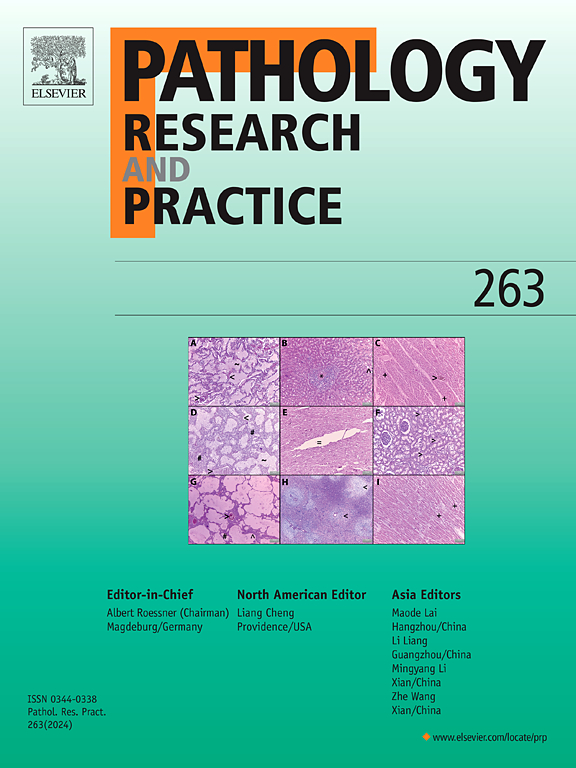Delivery of doxorubicin by Fe3O4 nanoparticles, reduces multidrug resistance gene expression in ovarian cancer cells
IF 2.9
4区 医学
Q2 PATHOLOGY
引用次数: 0
Abstract
Background
Ovarian cancer is one of the most common malignancy in women with significant mortality rate due to the resistance to chemotherapy drugs. Doxorubicin (DOX) is a chemotropic agent in ovarian cancer treatment. Overexpression of multidrug resistance (MDR) genes, such as ABCB1, in cancer cells after chemotherapy is one of main problems in clinical applications. Here we have compared the efficiency of doxorubicin-loaded (NIPAAM-DMAEMA) Fe3O4 nanocomposite (DOX-NANO) against DOX on ABCB1(MDR1) gene expression in the ovarian cancer cell line.
Materials and methods
The cell viability of SKOV-3 cells were evaluated by MTT assay. Real Time PCR was used to measure the expression level of MDR1. MTT data were normalized in 10 different attribute weighting models, also to reveal the interaction between DOX, ABCB1, and ovarian cancer genes, Pathway Studio Database (Elsevier) was used.
Results
Cell viability of SKOV-3cells was significantly decreased after 24, 48 and 72 hours (P < 0.0001) of either DOX with IC50 22.38, 0.61 and 0.072 µg/ml or DOX-NANO treatment with IC50 11.54, 1.01, 0.0126 µg/ ml respectively. treatment. Notable decrease in the expression of MDR gene, ABCB1, was observed 48 hours after treatment with DOX-NANO (P < 0.0001) with 26 % in the assessed with control group. Meta-analysis showed the concentration of 10 μg/ml variables was the second most significant feature, whereas the concentration of 0.01 μg/ml recognized the lowest weights. Also, LGALS3 is an extra cellular receptor with upregulation in ovarian cancer that interacts with ABCB1.
Conclusion
Our findings highlight the beneficial effects of DOX delivery in ovarian cancer cells by nanocomposite as efficient drug delivery method. DOX-NANO is a promising therapeutic reagent to overcome chemotherapy resistance in ovarian cancer.
用 Fe3O4 纳米颗粒递送多柔比星,减少卵巢癌细胞中多药耐药基因的表达
背景卵巢癌是女性最常见的恶性肿瘤之一,由于对化疗药物产生抗药性,死亡率很高。多柔比星(DOX)是治疗卵巢癌的一种化学药物。化疗后癌细胞中ABCB1等多药耐药(MDR)基因的过度表达是临床应用中的主要问题之一。在此,我们比较了负载多柔比星(NIPAAM-DMAEMA)的 Fe3O4 纳米复合材料(DOX-NANO)与 DOX 对卵巢癌细胞株中 ABCB1(MDR1)基因表达的影响。采用实时 PCR 检测 MDR1 的表达水平。此外,为了揭示 DOX、ABCB1 和卵巢癌基因之间的相互作用,还使用了 Pathway Studio 数据库(Elsevier)。结果SKOV-3细胞在DOX(IC50分别为22.38、0.61和0.072微克/毫升)或DOX-NANO(IC50分别为11.54、1.01和0.0126微克/毫升)处理24、48和72小时后,细胞活力明显下降(P< 0.0001)。用 DOX-NANO 治疗 48 小时后,观察到 MDR 基因 ABCB1 的表达显著下降(P < 0.0001),对照组的降幅为 26%。元分析表明,浓度为 10 μg/ml 的变量是第二大显著特征,而浓度为 0.01 μg/ml 的变量权重最低。此外,LGALS3 是卵巢癌中上调的细胞外受体,它与 ABCB1 相互作用。DOX-NANO是克服卵巢癌化疗耐药性的一种很有前景的治疗试剂。
本文章由计算机程序翻译,如有差异,请以英文原文为准。
求助全文
约1分钟内获得全文
求助全文
来源期刊
CiteScore
5.00
自引率
3.60%
发文量
405
审稿时长
24 days
期刊介绍:
Pathology, Research and Practice provides accessible coverage of the most recent developments across the entire field of pathology: Reviews focus on recent progress in pathology, while Comments look at interesting current problems and at hypotheses for future developments in pathology. Original Papers present novel findings on all aspects of general, anatomic and molecular pathology. Rapid Communications inform readers on preliminary findings that may be relevant for further studies and need to be communicated quickly. Teaching Cases look at new aspects or special diagnostic problems of diseases and at case reports relevant for the pathologist''s practice.

 求助内容:
求助内容: 应助结果提醒方式:
应助结果提醒方式:


